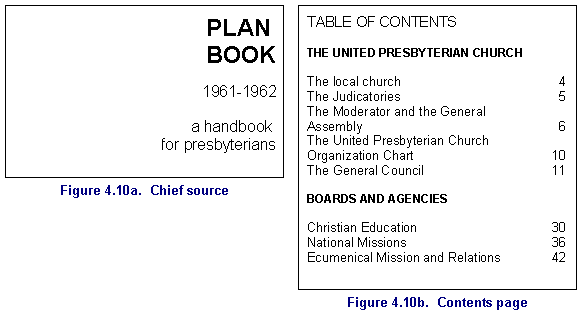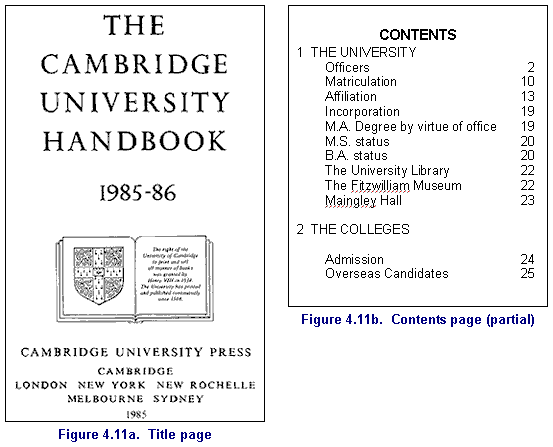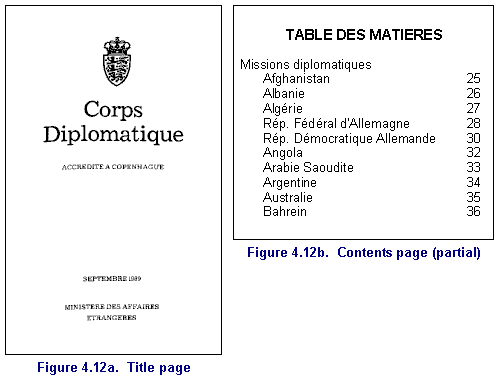Cataloger's Reference Shelf
CONSER Cataloging Manual
4.4. Does the serial fall into one of the categories under AACR2 21.1B2?
A serial is entered under corporate body when:
-- it is about the body (category A)
-- it is a legal publication that falls into one of the special types in category B
-- it contains the opinions of the body (category C)
-- it records the activities of a conference, exhibition, or other ad hoc event (category D)
-- it is the result of the collective activity of a performing group, where the responsibility of the group goes beyond that of performance (e.g., sound recordings, films, videorecordings) (category E)
-- it is cartographic material that emanates from a corporate body that is not merely responsible for the publication or distribution of the material (category F)
Category B is covered in Module 34. This module will discuss categories A (about the corporate body), C (expressing the opinions of the corporate body), and D (conferences, exhibits, events).
When applying AACR2 21.1B2, consider the emphasis or purpose of the serial. Why is it being issued? In general, if the serial is issued to present the activities, resources, or opinions of the body, enter it under the body; if the serial is issued to present current information, findings, results of research, etc. about a topic, enter it under the title.
4.4.1. Category A: "Those of an administrative nature dealing with the corporate body itself"
Most serials that are entered under corporate body fall under this category. To be considered here, the publication must be of an "administrative nature" and include information that is about the activities of the corporate body or internal to its operations. LCRI 21.1B2 defines administrative nature as:
works dealing with the management or conduct of the affairs of the body itself, including works that describe the activities of the body either in general terms or for a particular period of time, e.g., minutes of meetings, reports of activities for a particular period.
Examples of serials that usually fit this category are: annual reports, provided that they are about the body and not about matters external to the body; directories of staff or members of an organization; budgets or other reports about the finances of the corporate body; internal procedure manuals, lists of program grants awarded by a body, and catalogs of collections held by a corporate body. Also included are bibliographies or lists of publications issued by a corporate body and indexes of the body’s publications.

The serial in Figure 4.10. emanates from the United Presbyterian Church and the contents reveal that the serial is about the body--its organization, programs, etc. Thus, it falls under AACR2 21.1B2 and is entered under the church.
110 2# $a United Presbyterian Church in the U.S.A.
245 10 $a Plan book.

The Cambridge University Handbook also falls under AACR2 21.1B2 because it is about the University--its officers, programs, courses of study, and so forth.
110 2# $a University of Cambridge.
245 14 $a The Cambridge University handbook.
Further examples:
110 1# $a Eastern Region (Nigeria)
245 10 $a Approved estimates of the Eastern Region.
110 2# $a Cleveland Orchestra.
245 10 $a In concert : $b the newsletter of the Cleveland Orchestra.
110 1# $a New York (State). $b Office of the State Deputy Comptroller for the City of New York.
245 10 $a Financial plan status report.
110 2# $a New York Sea Grant Extension Program.
245 10 $a Annual report of accomplishments and activities.
110 1# $a Pleasant Hill (Calif.)
245 10 $a Annual budget for the city of Pleasant Hill, California.
110 2# $a University of Maryland at Baltimore. $b Dept. of Medicine.
245 10 $a Research and educational activities.
110 2# $a University of the State of New York. $b Regents College.
245 10 $a Student handbook.
110 2# $a American Osteopathic Association.
245 14 $a The osteopathic directory and year book of the A.O.A. for ...
Examples of serials that do not fit this category are: reports on matters external to the corporate body, particularly statistical publications that are not about the corporate body itself; reports of research done by the corporate body that are issued primarily to present the results of the research; directories or lists of persons that are not affiliated with one particular corporate body; financial publications that are not the budget or revenues of a corporate body.

Figure 4.12. does not fall under AACR2 21.1B2 because it consists of a list of diplomats from other countries that are located in Copenhagen. The serial is entered under title.
245 00 $a Corps diplomatique accrédité à Copenhague.
Further examples:
245 00 $a Agency : $b a publication of the American Association of Agencies.
245 00 $a AFTE journal.
245 00 $a American organist.
(issued by the American Guild of Organists)
245 00 $a EGSA buyer's guide & member services directory / $c Electrical Generating Systems Association.
245 04 $a The Georgia post-secondary school directory.
(issued by Georgia Student Finance Commission)
245 00 $a Occasional paper series.
(issued by Institute for East-West Security Studies; this title would also require a uniform title)
245 00 $a Foreign consular representation in Finland.
The category "resources" may be interpreted to include catalogs and bibliographies. Catalogs are defined as the holdings of an institution, such as a catalog of books held by a library or a catalog of art works owned by a museum. Such works are entered under the heading for the library or museum because they represent the holdings or resources of the institution. Bibliographies can fall into several categories and main entry is often more difficult to determine. Again, consider the focus of the bibliography. If the purpose is to show the activities of members of a society by presenting a bibliography of articles written during the year, the bibliography would be entered under the society. If, however, a society issues a bibliography for the purpose of presenting recent works on a particular topic, enter under the title.
Under corporate body:
110 2# $a National Archive of Computerized Data on Aging (U.S.)
245 10 $a Data collections from the National Archive of Computerized Data on Aging.
110 2# $a Healthcare Information and Management Systems Society.
245 10 $a Catalog of healthcare information and management systems publications.
110 2# $a University of Delhi.
245 10 $a Annual convocation ... handbook of research activities.
Under title:
245 00 $a Catalog of California state grants assistance / $c California State Library
245 00 $a Bibliography of English language and literature / $c compiled by members of the Modern Humanities Research Association.
Determining the entry for newsletters can be difficult because they often contain information about a body and about general subject matter external to the body. The first issue may be misleading because it may focus on introducing the society or organization to its readers. For example, the first issue of To the Point introduces the newly formed Colored Pencil Society of America to its readers with articles on the founders, bylaws, and so forth, while later issues focus on the subject of colored pencil drawing. As a rule, consider any statements of intent about the purpose of the newsletter. If it is clear that the purpose is to disseminate information about the activities of the body, then enter under the body. If this is not clear, assume that the newsletter will cover general information that is both internal and external and enter under title.
|
|
|
|
The Gazette is entered under the heading for the Library of Congress because it contains news about LC and LC employees.
110 2# $a Library of Congress. 245 14 $a The gazette / $c Library of Congress. |
|
The primary focus of the Library of Congress Information Bulletin is to inform those outside of LC about library-related meetings and activities that are not limited to those held at the Library of Congress. Because the scope is much broader than that of The Gazette, the Information Bulletin is entered under title.
245 00 $a Library of Congress information bulletin. |
|
|
|
This newsletter is published by the Great Migration Study Project, a project of the New England Historic Genealogical Society. According to the editor, "The purpose of the Great Migration Newsletter is to inform you of the progress of the Project itself, to discuss the sources that will be studied in carrying out the research, and also to bring you information on recent genealogical discoveries pertaining to these earliest immigrants to New England." The newsletter has been entered under title because it contains a mixture of information that is more than just administrative. |
245 00 $a Great migration newsletter.
710 2# $a Great Migration Study Project (New England Historic Genealogical Society)
4.4.2. Category C: "Those that record the collective thought of the body"
This category applies to serials less frequently, but when it does it most often applies to reports of committees and commissions that are issued regularly and contain statements of the opinions and/or recommendations of the committee or commission. Often the report contains a significant amount of background information that substantiates the recommendations. Consider the overall purpose of the publication. If the serial is issued to present recommendations, it qualifies for entry under corporate body, regardless of the amount of text devoted to the background material. Consider also the function of the body itself. Often committees or commissions are established for the primary purpose of making recommendations to another or higher body. Information about the function of the body is often included in the introductory pages of the serial. Other examples of serials in this category are standards, building codes, and rules of a sport, such as the Official NBA Rules.
|
|
In Figure 4.16., the National Association of Railroad and Utilities Commissioners is presented as the publisher. The Committee on Service and Facilities of Transportation Agencies is a subordinate body given prominently in the title. The serial contains the opinions and recommendations of the Committee–the "collective thought"–and thus, falls under category C of AACR2 21.1B2. The serial is entered under the heading for the subordinate body. |
110 2# $a National Association of Railroad and Utilities Commissioners. $b Committee on Service and Facilities of Transportation Agencies.
245 10 $a Report of the Committee on Service and Facilities of Transportation Agencies / $c National Association of Railroad and Utilities Commissioners.
Further examples:
110 2# $a New York State Commission on Child Support.
245 10 $a Report submitted to Governor ...
110 1# $a United States. $b Strategy Council on Drug Abuse.
245 10 $a Federal strategy for drug abuse and drug traffic prevention.
110 2# $a Little League Baseball, inc.
245 10 $a Official regulations and playing rules / $c Little League Baseball.
4.4.3. Category D: "Conferences, exhibitions, and ad hoc events"
There are two types of publications that can be considered conference publications: 1) periodic meetings of the members of a society, association, etc. and 2) periodic meetings that focus on a specific topic. In the first case, the "name" of the conference may consist of words such as "Meeting", "Convention", or "Seminar". In the second case the name is more likely to be "Conference on ...", "Symposium on ...", and so forth. For instructions on setting up headings for conferences, see Module 18.
Enter a serial under the heading for a conference when it presents the proceedings, reports, activities, etc. of the conference. Do not enter a serial under a conference heading when the serial contains only a separate report presented at the conference.
A serial can be entered under the name of a conference when the conference is named anywhere in the piece (LCRI 21.1B2 ). This is a change in the rules; prior to 2001, conferences had to be named on the chief source in order to be used as main entry.
|
|
Figure 4.17. is an example of the first type of conference publication because it contains the proceedings of the meeting of an association. Entry is under the name of the association plus the subheading for the meeting (see also Module 18 for the construction of conference headings.)
110 2# $a International Textile and Apparel Association. $b National Meeting. 245 10 $a ITAA proceedings / $c National Meeting. |
|
Figure 4.18. is an example of the second type of conference publication, one that deals with a specific topic. Entry for this publication is under the heading for the conference (see also Module 18 for omissions from the name). |
|
111 2# $a Symposium on Computer Arithmetic.
245 10 $a Proceedings / $c IEEE Symposium on Computer Arithmetic.
Further examples:
111 2# $a Paper Finishing & Converting Conference.
245 10 $a Paper Finishing & Converting Conference : $b [proceedings].
111 2# $a Ohio Transportation Engineering Conference.
245 10 $a Proceedings of the ... Annual Ohio Transportation Engineering Conference.
110 2# $a American Bar Association. $b Section of Family Law. $b Meeting.
245 10 $a Annual meeting compendium.
4.4.4. In case of doubt, enter under the title
Apply this instruction given under AACR2 21.1B2 whenever the situation is not clear.
See also:
Module 4. Main and Added Entries (Fields 100-111 and 700-711)